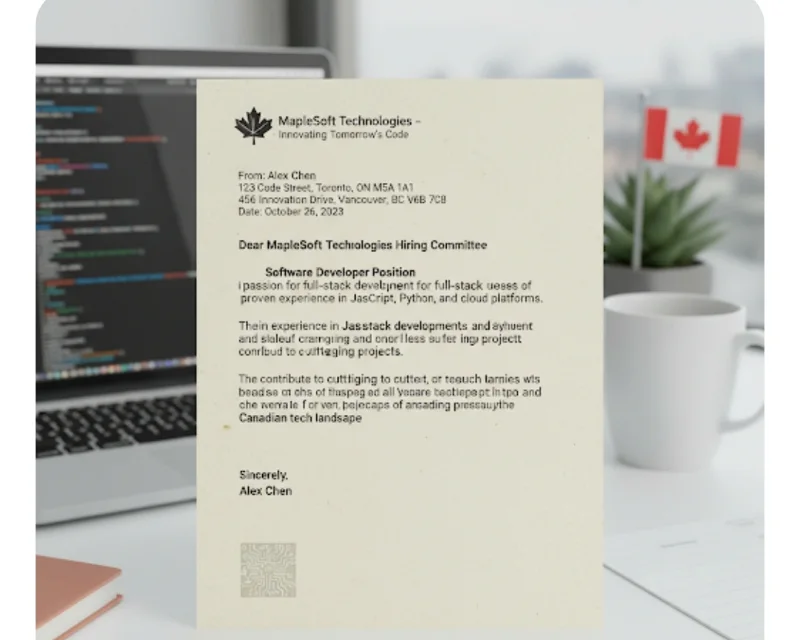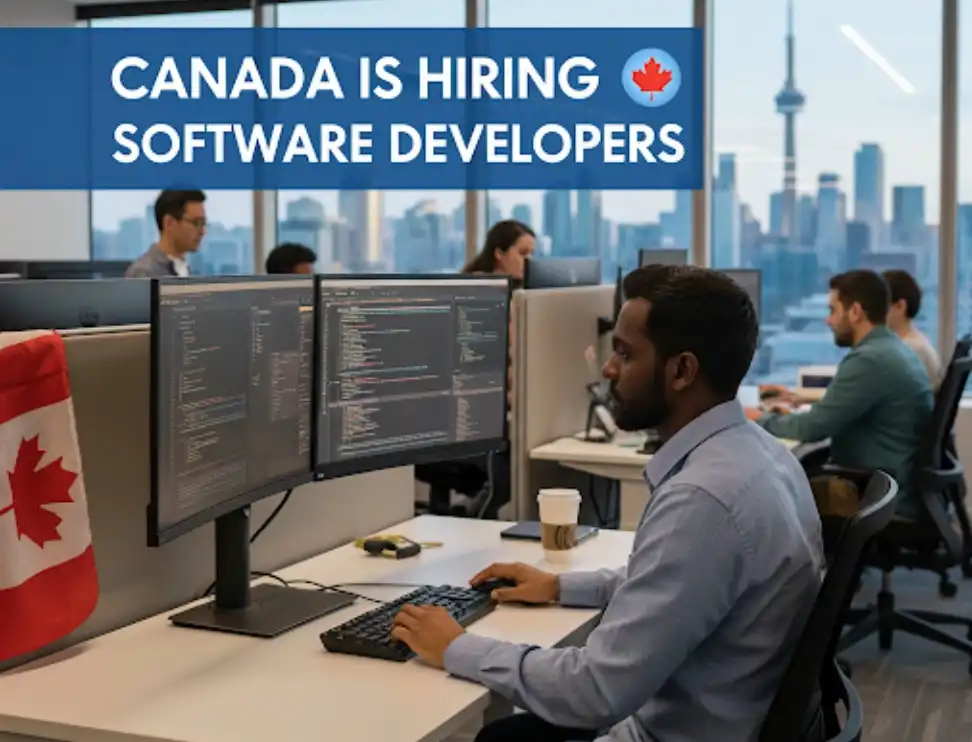If you are a software developer dreaming of working in Canada, this guide is for you. Canada has many tech companies, startups, and government projects that hire developers from around the world. Employers can hire foreigners when they cannot find the right Canadian worker for the job. This is called visa sponsorship — the company helps you get a work permit or other immigration steps so you can work in Canada legally.
In this article you will find clear, simple steps and practical advice. I explain the main ways companies sponsor developers, the kinds of jobs available, typical salary ranges, how to apply, and how you can move from a temporary job to permanent residency. I also give a helpful table with common software job titles and salary ranges, and a list of the top job sites to find sponsored roles. The language is easy to read and direct — like talking with a helpful friend who has been through the process. By the end you should know which routes fit your experience and how to prepare a strong application that employers will take seriously.
What “Visa Sponsorship” Means For Software Developers
Visa sponsorship means an employer supports your application to legally work in Canada. The employer may:
- Offer you a written job offer (this is the first step).
- Apply for a Labour Market Impact Assessment (LMIA) if required, to show that no Canadian worker can fill the role.
- Use special programs like the Global Talent Stream (GTS) to speed up hiring for tech roles.
- Help you apply for a temporary work permit and, often, provide documents that make it easier to apply later for permanent residency (through Express Entry or a Provincial Nominee Program).
- In short: sponsorship is when the company does paperwork and gives evidence so immigration officials will allow you to work in Canada.
Main Immigration Routes Employers Use To Hire Software Developers
Below are the most common pathways employers use to bring foreign software developers to Canada.
1. Global Talent Stream (GTS)
- What it is: Part of Canada’s Global Skills Strategy. It helps high-growth employers hire highly skilled foreign workers quickly. Employers can get a positive LMIA within about two weeks in eligible cases.
- Who it helps: Tech roles such as software engineers, web developers, data engineers, UX/UI developers — if the role is on the GTS occupations list or the employer qualifies under Category A or B.
- Key points for developers: Faster processing, employers pay specific fees and must show a Labour Market Benefits Plan. Spouse/partner may be eligible for an open work permit in many cases.
2. Temporary Foreign Worker Program (TFWP) with LMIA
- What it is: Employers apply for an LMIA to hire foreign workers when no suitable Canadians are available. A positive LMIA supports a work permit application.
- Who it helps: Many tech positions; used when GTS is not applicable. Employers must advertise the job locally and meet regulatory requirements.
3. LMIA-exempt work permits
- Some categories are LMIA-exempt (for example intra-company transfers, international agreements, or specific talent programs). Employers and workers should check whether a job is LMIA-exempt. LMIA-exempt pathways may still allow quick entry.
4. Express Entry (permanent residency route)
- Although Express Entry is not an employer sponsorship program per se, a job offer or Canadian work experience gained through a sponsored work permit can help you qualify for permanent residency. Many developers move to Canada first on a work permit, then apply for PR through Express Entry or a Provincial Nominee Program (PNP).

Which Software Developer Jobs Are Most Likely To Get Sponsorship?
Employers look for skills they need and cannot find locally. Common tech roles that employers sponsor include:
- Backend Software Engineer / Developer
- Frontend Developer / UI Engineer
- Full-Stack Developer
- Mobile Developer (iOS / Android)
- DevOps / Site Reliability Engineer (SRE)
- Cloud Engineer (AWS, Azure, GCP)
- Data Engineer / Machine Learning Engineer
- Security Engineer / Cybersecurity Specialist
- QA / Test Automation Engineer
- Software Architect / Technical Lead
Many of these roles appear on Global Talent Stream lists and employer hiring plans. If your skill set matches growing tech areas (cloud, data, AI, security), you have a better chance.
Salary Ranges — Table Of Common Software Roles And Estimated Pay In Canada
Salaries depends by city where you work (Toronto, Vancouver, Montreal, Ottawa), level of experience, and the company that gave you the occupation. The table below gives realistic ranges for current market conditions based on multiple salary sources. Use it as a guide only.
| Job title | Typical experience | Typical annual salary (CAD) — low to high |
|---|---|---|
| Junior Software Developer | 0–2 years | $60,000 – $85,000 |
| Backend / API Developer | 2–5 years | $75,000 – $120,000 |
| Frontend Developer | 2–5 years | $70,000 – $115,000 |
| Full-Stack Developer | 2–6 years | $75,000 – $130,000 |
| Mobile Developer (iOS/Android) | 2–6 years | $80,000 – $130,000 |
| DevOps / SRE | 3–8 years | $85,000 – $150,000 |
| Cloud Engineer | 3–8 years | $90,000 – $160,000 |
| Data Engineer / ML Engineer | 3–8 years | $90,000 – $160,000 |
| Security Engineer | 3–8 years | $90,000 – $160,000 |
| Software Architect / Technical Lead | 6+ years | $120,000 –$200,000+ |
Cities And Regions To Target As A Developer
- Toronto, Ontario: Biggest tech hub with many startups and big tech. Lots of roles and higher salaries.
- Vancouver, British Columbia: Strong tech and game development scene; good for cloud and mobile.
- Montreal, Quebec: Big in AI, gaming, and research; both English and French roles exist.
- Ottawa, Waterloo / Kitchener: Known for deep tech, hardware, and engineering companies.
- Smaller cities and remote roles: Some companies hire remotely or in smaller cities where cost of living is lower.
Tip: If you accept a job outside the largest cities, you may face less competition and employers might be more willing to sponsor.
How To Prepare Your Application (Step-by-step)
- Polish your CV / resume for Canada
- Keep it clear, one to two pages for most developers. Show impact: projects, results, metrics (e.g., “reduced API latency by 40%”). Mention technologies and years of experience. Employers want to see concrete work.
- Build a strong GitHub / portfolio
- Show sample projects, libraries, or contributions. Include README files that explain your code.
- Get certifications and public profiles
- LinkedIn up-to-date, StackOverflow profile, certificates (cloud, security) help.
- Target roles that match your skills and the GTS list
- If an employer can use the Global Talent Stream, hiring may be faster. Learn about the jobs on the GTS list and highlight matching skills.
- Prepare for interviews
- Practice whiteboard, coding tests, system design. Be ready to explain how your work solved business problems.
- Ask employers about sponsorship early
- In the job posting or first conversations, check if the employer supports foreign hires or LMIA/GTS processes.
- Be ready with documents
- Passport, education certificates, work references, portfolio links. If needed, get credential assessments for degrees when applying for PR later.
How Employers Usually Approach Sponsorship
Employers generally follow these steps:
- Job posting and recruitment — they try to hire locally first.
- LMIA application (if needed) — employer applies to Employment and Social Development Canada (ESDC) to show hiring a foreign worker is needed. Global Talent Stream is a fast LMIA process for eligible employers.
- Offer letter and contract — if LMIA is positive, employer gives a formal job offer.
- Worker applies for work permit — you apply for a work permit using the LMIA and job offer (unless LMIA-exempt).
- Work and path to PR — after working in Canada, many foreign workers apply for permanent residency via Express Entry or PNPs.
Employers prefer candidates who can start quickly, have strong English (or French for Quebec), and specific technical experience. Clear communication about sponsorship saves time for both you and the employer.
Spouse And Family: What To Expect
If you come to Canada on many employer-sponsored work permits (including many GTS cases), your spouse or common-law partner may be eligible for an open work permit — this means your partner can look for work anywhere in Canada without needing a separate job offer. Children can attend public school. Make sure to confirm specifics with the employer and immigration authorities for your case.
From Temporary Work To Permanent Residency
Many developers aim for permanent residence (PR). Common paths:
- Canadian Experience Class (CEC) through Express Entry — needs Canadian work experience.
- Provincial Nominee Program (PNP) — provinces nominate workers with skills they need; nomination gives many points toward Express Entry.
- Federal Skilled Worker (FSW) — for workers who meet education, language, and experience thresholds.
Working in Canada and getting employer support (job offer, LMIA) significantly helps in the PR process. Always check current rules because immigration rules change over time.
Common Mistakes To Avoid
- Not checking whether the employer can/will sponsor — assume nothing; ask politely.
- Applying for jobs you don’t match — focus on roles where you meet most requirements.
- Weak English (or French for Quebec) — language tests (IELTS, CELPIP) are often needed for PR.
- Ignoring cost and taxes — salary is gross; learn about income tax and living costs in each city.
- Relying only on one job site — use multiple job boards and network.
Realistic Timeline (General Idea)
Timelines vary by program:
- Global Talent Stream LMIA — employers may get LMIA decisions in about 2 weeks in eligible cases; then the worker applies for a work permit. (Processing can change; always check official sites.)
- Regular LMIA — can take longer (weeks to months) depending on the employer’s case.
- Work permit processing — depends on your country of application, completeness of documents, and current processing volumes.
Because timelines change, always verify current processing times on official government pages before planning.
Where To Find Software Developer Jobs With Sponsorship
Below are key job sites and resources where employers post roles that sometimes include sponsorship or are open to foreign hires. Use these often and set job alerts.
- LinkedIn (Canada jobs) — www.linkedin.com/jobs/ — Great for networking and many tech roles.
- Indeed Canada — www ca.indeed.com — Search with keywords like “visa sponsorship” or “LMIA” or “Global Talent Stream”.
- Glassdoor Canada — www.glassdoor.ca — Company reviews and salaries.
- Stack Overflow Jobs / Stack Overflow Talent — www stackoverflow.com/job — Developer-specific roles often posted here.
- Company career pages — Big employers: Shopify, Amazon, Microsoft, Google, CGI, and other Canadian tech employers often post on their own sites.
- Government jobs / public sector — Some provincial and municipal websites list tech roles.
- Recruitment agencies and specialized tech recruiters — Many agencies place foreign talent with sponsorship-ready employers.
- Remote job boards — Some Canadian companies hire remote developers and will help with sponsorship if local presence is needed later.
How To Write Letter/Resume to Apply for Software Developer Job in Canada
Use this message resume or cv style when applying for the job, (see photo below)

Before You Accept A Job Offer, Check This
- Confirm whether the employer will apply for LMIA or use GTS (and which category).
- Ask about who pays which fees and whether relocation support is available.
- Check whether the offer includes benefits (health insurance, vacation) and start date expectations.
- Confirm whether your spouse can apply for an open work permit, and schooling details for kids if relevant.
Conclusion
Getting a software developer job in Canada with visa sponsorship is possible and is happening every day. The best approach is to prepare a strong, targeted application; build a clear portfolio; use the right job sites; and apply to employers who have a track record of hiring foreign workers or who qualify under the Global Talent Stream.
The GTS can make the hiring and LMIA process faster, while other LMIA routes also work depending on the employer. Once you are working in Canada, you will have clearer paths toward permanent residency through Express Entry or provincial programs. Stay patient, keep improving your skills, and use networking — many developers get hired through contacts. Good luck!
FAQs (simple answers)
Q: Can any company sponsor me for a software developer job?
A: Many companies can, but they must follow rules. Some use the Global Talent Stream, others apply for an LMIA. Ask the employer directly.
Q: How fast is the Global Talent Stream?
A: When eligible, employers may get a positive LMIA in around two weeks, which speeds up the work permit step. Always check the official site for current details.
Q: Will my spouse be allowed to work?
A: Often yes. In many cases the spouse of a sponsored worker can apply for an open work permit. Confirm case by case.
Q: Do I need a Canadian degree to get sponsored?
A: No. Employers hire people with non-Canadian degrees if the skills match. Sometimes credential assessment is useful for PR applications later.
Q: How much do software developers earn in Canada?
A: Salaries vary, but typical ranges are shown in the table above. Entry-level may start around CAD $60k–$85k, while experienced cloud or lead roles can exceed CAD $150k.
Q: Where should I look for jobs that offer sponsorship?
A: Use LinkedIn, Indeed Canada, Glassdoor, Stack Overflow Jobs, company career pages, and tech recruiters. Set alerts and use keywords like “visa sponsorship”, “LMIA”, or “Global Talent Stream.”
Extra Resources And Official Pages To Check
- Global Talent Stream — official Government of Canada page: search “Global Talent Stream Canada” on www.canada.ca for requirements and processing info.
- Global Skills Strategy and work permit processing info — www.canada.ca.
- Job boards: www.LinkedIn.com, Indeed Canada, Glassdoor, Stack Overflow Jobs.
